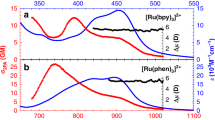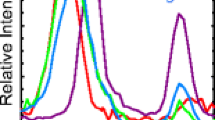Abstract
Solvatochromism is commonly used in many fields of chemical and biological research to study bulk and local polarity in macro systems (membranes, etc.), or even the conformation and binding of proteins. Despite its wide use, solvatochromism still remains a largely unknown phenomenon due to the extremely complex coupling of many different interactions and dynamical processes which characterize it. In this work the spectroscopic characterization of the Ru(acac)2(L) complex (1) [HL = N-(2-methylsulfonyl-phenyl)formamide] are presented. Gas- and solution-phase structural and electronic features of (acac)2Ru(L) have been investigated using density functional theory. The molecular structure underscores the flexibility of the formyl fragment in the metal complex. Time-dependent density functional theory has been used to investigate the excited states and solvatochromic properties of Ru(acac)2(L). The calculated vertical excitation energies in solution are consistent with the experimental data, showing that the ligand-to-metal charge-transfer transitions, in both the visible and UV regions, dominate over the ligand based π–π* transitions.








Similar content being viewed by others
REFERENCES
A. B. P. Lever, in Inorganic Electronic Spectroscopy, 2nd ed. (Elsevier, Amsterdam, 1984), p. 208.
A. Kundt, Ann. Phys. Chem., N. F. 4, 34 (1878); Chem. Zentralbl., 498 (1878); G. Scheibe, E. Felger, and G. Rossler, Ber. Dtsch. Chem. Ges. (1927); S. E. Sheppard, Rev. Mod. Phys. 14, 303 (1942).
C. Reichardt, Solvent and Solvent Effects in Organic Chemistry, 3rd ed. (Wiley-VCH, Weinheim, 2002); P. Suppan and N. Ghoneim, Solvatochromism (The Royal Society of Chemistry, Cambridge, 1997).
S. R. Marder, D. N. Beratan, and L. T. Cheng, Science (Washington, DC, U. S.) 252, 103 (1991); S. R. Marder, C. B. Gorman, F. Meyers, J. W. Perry, G. Bourhill, J. L. Bredas, and B. M. Pierce, Science 265, 632 (1994); F. Meyers, S. R. Marder, B. M. Pierce, and J. L. Bredas, J. Am. Chem. Soc. 116, 10703 (1994); T. J. Marks and M. A. Ratner, Angew. Chem. 34, 155 (1995); C. B. Gorman and S. R. Marder, Proc. Natl. Acad. Sci. U. S. A. 90, 11297 (1993).
S. R. Marder, in Inorganic Materials, Ed. by D. W. Bruce and D. O’Hare (Wiley, Chichester, U.K., 1992); D. R. Kanis, M. A. Ratner, and T. J. Marks, Chem. Rev. 94, 195 (1994); N. J. Long, Angew. Chem., Int. Ed. Engl. 34, 21 (1995).
D. R. Kanis, M. A. Ratner, and T. J. Marks, J. Am. Chem. Soc. 112, 8203 (1990); D. R. Kanis, M. A. Ratner, and T. J. Marks, Chem. Mater. 3, 19 (1991); D. R. Kanis, M. A. Ratner, and T. J. Marks, J. Am. Chem. Soc. 114, 10338 (1992); D. R. Kanis, P. G. Lacroix, M. A. Ratner, and T. J. Marks, J. Am. Chem. Soc. 116, 10089 (1994).
M. Schröder and T. A. Stephenson, in Comprehensive Coordination Chemistry, Ed. by G. Wilkinson, R. D. Gillard, and J. A. McCleverty (Pergamon, Oxford, U.K., 1987), Vol. 4.
S. Chatterjee, Transition Metal Complex of Redox Non-Innocent N,S Mixed-Donor Ligand (Scholar’s Press, Germany, 2014).
S. Chatterjee, S. Mandal, S. Samanta, and S. Goswami, Dalton Trans. 41, 7057 (2012).
G. t. Velde, F. M. Bickelhaupt, E. J. Baerends, C. F. Guerra, S. J. A. v. Gisbergen, J. G. Snijders, and T. Ziegler, J. Comput. Chem. 22, 931 (2001), ADF2006.01, SCM, Theoretical Chemistry, Vrije Universiteit, Amsterdam, The Netherlands. http://www.scm.com.
M. J. Frisch et al., Gaussian 03 (Gaussian Inc., Pittsburgh, PA, 2003).
A. D. Becke, Phys. Rev. A 38, 3098 (1988).
C. Lee, W. Yang, and R. G. Parr, Phys. Rev. B 37, 785 (1988).
A. Klamt and G. Schüürmann, J. Chem. Soc., Perkin Trans. 2, 799 (1993), A. Klamt and V. Jonas, J. Chem. Phys. 105, 9972 (1996).
C. C. Pye and T. Ziegler, Theor. Chem. Acc. 101, 396 (1999).
S. Miertuš, E. Scrocco, and J. Tomasi, Chem. Phys. 55, 117 (1981); M. Cossi, V. Barone, R. Cammi, and J. Tomasi, Chem. Phys. Lett. 255, 327 (1996).
A. D. Becke, J. Chem. Phys. 98, 1372 (1993).
A. L. Tenderholt, QMForge: A Program to Analyze Quantum Chemistry Calculations. Version 2.1. http://qmforge.sourceforge.net.
M. J. Kamlet, J.-L. M. Abboud, and R. W. Taft, J. Am. Chem. Soc. 99, 6027 (1977).
A. Masternak, G. Wenska, J. Milecki, B. Skalski, and S. Franzen, J. Phys. Chem. A 109, 759 (2005).
S. L. Murov, I. Carmichael, and G. L. Hug, Handbook of Photochemistry, 2nd ed. (Marcel Dekker, New York, 1993).
E. Kosover, J. Am. Chem. Soc. 80, 3253 (1958).
C. Reichardt, Angew. Chem., Int. Ed. Engl. 4, 29 (1965), C. Reichardt, Solvents and Solvent Effects in Organic Chemistry, 2nd ed. (Wiley-VCH, Weinheim, Germany, 1988); J. Catalán, J. Org. Chem. 62, 8231 (1997).
Y. Marcus, Chem. Soc. Rev. 22, 409 (1993).
V. N. Nemykin and P. Basu, Inorg. Chem. 42, 4046 (2003); R. L. McNaughton, S. Mondal, V. N. Nemykin, P. Basu, and M. L. Kirk, Inorg. Chem. 44, 8216 (2005); F. Wang and T. Ziegler, Mol. Phys. 102, 2585 (2004); V. N. Nemykin, J. G. Olsen, E. Perera, and P. Basu, Inorg. Chem. 45, 3557 (2006).
F. Aquilante, M. Cossi, O. Crescenzi, G. Scalmani, and V. Barone, Mol. Phys. 101, 1945 (2003).
ACKNOWLEDGMENTS
SC thanks Dr. Prosenjit Seal for his thoughtful inputs in carrying out the works and some valuable help. SC also thanks Scholar’s Press to give the permission to publish the data, mentioned in the book “Transition Metal Complex of Redox Non-Innocent N,S Mixed-Donor Ligand” published by the same author, in this article.
Author information
Authors and Affiliations
Corresponding author
Rights and permissions
About this article
Cite this article
Sudipta Chatterjee Solvatochromism of a Novel Ruthenium Complex, [Ru(acac)2(N-(2-Methylsulfonylphenyl)formamido)]: A Correlation between the Electronic Structure and Spectroscopic Properties. Russ. J. Phys. Chem. 94, 789–799 (2020). https://doi.org/10.1134/S0036024420040202
Received:
Revised:
Accepted:
Published:
Issue Date:
DOI: https://doi.org/10.1134/S0036024420040202




